COMMUNITY & PROGRAMS
CARIBBEAN & BLACK HERITAGE DEPARTMENT
The Caribbean & Black Heritage Department strives to introduce the culture, history, and legacy of Caribbean-Canadians and the Caribbean diaspora to the world while creating a tribute to the history of Caribana and its contributions to the City Of Toronto and the nation.
Our objectives are to contribute to the development of the arts and culture of Caribbean people, preserve the integrity of the artform and strengthen the community through projects and programs that promote cultural and social excellence.
The new department intends to provide a diverse offering of content and programming that celebrates and preserves these four areas:

HISTORY
EDUCATION
CARNIVAL ARTS
CARIBANA ARCHIVES
The History of Carnival
Caribana Festival (courtesy Archives of Ontario, Ministry of Transportation collection/RG14-151-3-149)
In the mid-1960s, Canada’s pending centennial anniversary fostered much excitement. Funding was offered and many groups began to think of ways to mark Canada’s 100th year. Within Toronto’s Black community, those having long roots in Canada, as well as those who had more recently arrived, joined together to plan. African liberation celebrations in May were uneasy gatherings. August 1st had been celebrated as Emancipation Day, the date reflecting the time of the legal end of African enslavement in British-controlled Canada and the Caribbean (August 1, 1834).
A new entity to reflect both the long-term and the more recent arrivals of the African diaspora in Canada was created to mark Canada’s centennial, the abolition of enslavement and the potential for African independence, using the model of “carnival.” Caribana was born, introducing new audiences to an interactive parade and raising the profile of African/Black/Caribbean foods, arts, culture, music and dance.
While it has grown to become the largest such event in the world, bringing in thousands of people to share in the experience, the goal of creating a Black community centre from the profits of Caribana has yet to be realized.
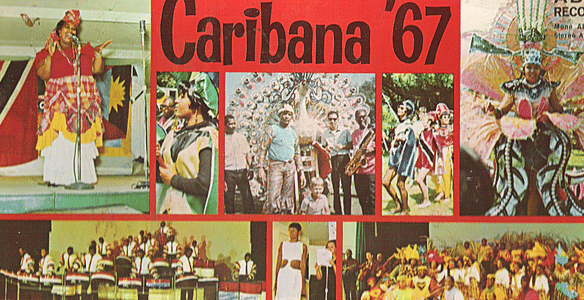
Caribana Timeline
1967
The first Caribana festival kicks off to celebrate Caribbean culture in the city of Toronto. Ten Caribbean individuals create the Caribbean Centennial Committee (CCC) and organize a festival as a gift to Canada for its Centennial year. Thousands of people visit the Olympic Islands for a sample of Caribbean music, food, and artifacts. The highlight of the festival is a spectacular parade along Yonge Street. Colourful mas bands jump up to the sound of Calypso and steel drums.
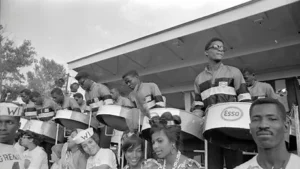
1968
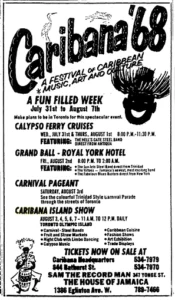 After the great success of the first Caribana festival in 1967, the Caribbean Centennial Committee (CCC) changes its name to the Caribbean Committee for Cultural Advancement (CCCA). They are determined to continue showcasing the beauty of Caribbean culture and begin to make plans about how they can improve and grow the Caribana festival.1969 The organizers of Caribana change their name for a third time to the Caribbean Cultural Committee – Caribana and focus on more than the festival itself. The group is committed to offer a variety of social services – interpretive dance classes, the formation of a steel band, the development of lectures and seminars for new immigrants from the Caribbean – to the Caribbean community.
After the great success of the first Caribana festival in 1967, the Caribbean Centennial Committee (CCC) changes its name to the Caribbean Committee for Cultural Advancement (CCCA). They are determined to continue showcasing the beauty of Caribbean culture and begin to make plans about how they can improve and grow the Caribana festival.1969 The organizers of Caribana change their name for a third time to the Caribbean Cultural Committee – Caribana and focus on more than the festival itself. The group is committed to offer a variety of social services – interpretive dance classes, the formation of a steel band, the development of lectures and seminars for new immigrants from the Caribbean – to the Caribbean community.
1971
Competitor Clive Brand just makes it out of his costume as it goes up in flames at the King and Queen Show. He is forced to throw his $400 costume into Lake Ontario to put the fire out. The blaze is a result of the two flares placed inside his costume to boldly display the colours to the judges. Although he loses his costume to the flames, he wins first place and is crowned King of the bands.
1984
Vanessa Williams is invited as a celebrity guest to the Caribana parade after she is crowned the first black Miss America. She retains her invitation, despite being forced to give up her crown when nude pictures of her surfaced and were released to the public.
1991
The Caribana parade moves locations. After 23 years of jumping up to the music along Yonge Street or University Avenue, the parade is set to take place at the CNE Grandstand and along Lakeshore Boulevard. The city and police recognize that they need a wider street for the bands and spectators to enjoy the parade and stay safe. Despite the move, thousands of visitors flock the city and Caribana continues to grow.
1998
Unfortunately, Johnny Cayonne, one of the founding members, dies of inoperable cancer on July 6, 1998.
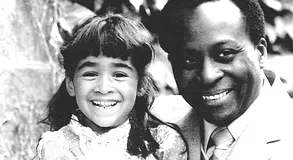
2004
The Caribbean Cultural Committee (CCC) fails to give the city a clean audit report for the spending of government grants in previous years. Consul General of Trinidad and Tobago steps in to help Toronto promote and grow the festival. By 2006, the Caribbean Cultural Committee (CCC) is forced to give up authority over Caribana and the festival temporarily changed its name to the Toronto Caribbean Carnival. A new organization is formed and Caribana carries on.
2007
Caribana celebrates its 40th birthday and is still jumping strong. In the battle of the mas bands, NBA player Jamaal Magloire’s, Toronto Revellers, take home first place in the competition. In only its second year as a competitive band, it won over the judges with its flashy Viva Las Vegas theme
EDUCATION
Caribbean Leaders in Canada
Caribana Festival (courtesy Archives of Ontario, Ministry of Transportation collection/RG14-151-3-149)
In the mid-1960s, Canada’s pending centennial anniversary fostered much excitement. Funding was offered and many groups began to think of ways to mark Canada’s 100th year. Within Toronto’s Black community, those having long roots in Canada, as well as those who had more recently arrived, joined together to plan. African liberation celebrations in May were uneasy gatherings. August 1st had been celebrated as Emancipation Day, the date reflecting the time of the legal end of African enslavement in British-controlled Canada and the Caribbean (August 1, 1834).
A new entity to reflect both the long-term and the more recent arrivals of the African diaspora in Canada was created to mark Canada’s centennial, the abolition of enslavement and the potential for African independence, using the model of “carnival.” Caribana was born, introducing new audiences to an interactive parade and raising the profile of African/Black/Caribbean foods, arts, culture, music and dance.
While it has grown to become the largest such event in the world, bringing in thousands of people to share in the experience, the goal of creating a Black community centre from the profits of Caribana has yet to be realized.

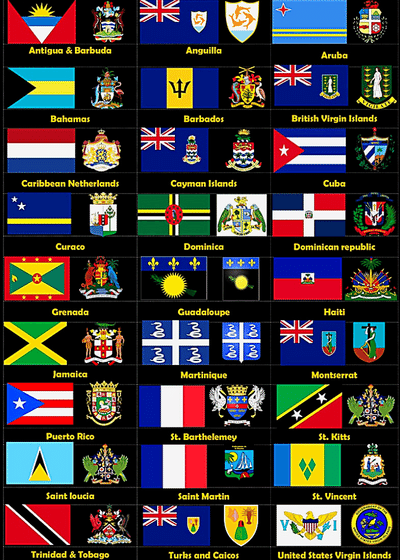
Island Spotlight
This is a list of islands of the Caribbean region, broadly defined to include islands surrounded by or bordering the Caribbean Sea as well as islands in the nearby Lucayan Archipelago, organized by the political entity to which each island belongs.
There are thousands of islands that are part of the island countries of the broadly defined Caribbean region: Anguilla has 21; Antigua-and-Barbuda has 37; Aruba (4); Bahamas (501 approximately); Barbados used to have 3 (but Pelican Island is now absorbed into Barbados through land reclamation, 1956–1961); British Virgin Islands (43); Cayman Islands (12); Cuba (23); Dominica (7); Dominican Republic (2); Grenada (39); Guadeloupe (38); Haiti (12); Honduras (6); Jamaica (26); Martinique (50); Montserrat (3); Netherlands Antilles (25, this includes half of Saint Martin); Puerto Rico (142); Saint Barthélemy (13); Saint Kitts-and-Nevis (20); Saint Lucia (17); Saint Martin (8); Saint Vincent-and-the-Grenadines (39); Trinidad-and-Tobago (21); Turks-and-Caicos Islands (58); and United States Virgin Islands (81). * Guyana and Bermuda are often mentioned along with these other nations although they are not not technically part of the Caribbean.
Some continental countries also have islands in the Caribbean, including Colombia (which has 10 islands in the Caribbean Sea, known as San Andrés-and-Providencia), Mexico (4 islands), Nicaragua (4), Venezuela (15), Belize, Guatemala, Honduras, Costa Rica and Panama. The United States also claims several small Caribbean islands (including Alto Velo).
From Wikipedia, the free encyclopedia
The History of Carnival
What is carnival?
It is an annual celebration of life found in many countries of the world. And in fact, by learning more about carnival we can learn more about ourselves and a lot about accepting and understanding other cultures.
Where did the word “carnival” come from?
Hundreds of years ago, the followers of the Catholic religion in Italy started the tradition of holding a wild costume festival right before the first day of Lent. Because Catholics are not supposed to eat meat during Lent, they called their festival, carnevale — which means “to put away the meat.” As time passed, carnivals in Italy became quite famous; and in fact the practice spread to France, Spain, and all the Catholic countries in Europe. Then as the French, Spanish, and Portuguese began to take control of the Americas and other parts of the world, they brought with them their tradition of celebrating carnival.
The dynamic economic and political history of the Caribbean are indeed the ingredients of festival arts as we find them today throughout the African and Caribbean Diaspora. Once Columbus had steered his boat through Caribbean waters, it was only a few hundred years before the slave trade was well established. By the early 19th century, some six million slaves had been brought to the Caribbean. Between 1836 and 1917, indentured workers from Europe, west and central Africa, southern China, and India were brought to the Caribbean as laborers.
African influences on carnival traditions
Important to Caribbean festival arts are the ancient African traditions of parading and moving in circles through villages in costumes and masks. Circling villages was believed to bring good fortune, to heal problems, and chill out angry relatives who had died and passed into the next world.
Carnival traditions also borrow from the African tradition of putting together natural objects (bones, grasses, beads, shells, fabric) to create a piece of sculpture, a mask, or costume — with each object or combination of objects representing a certain idea or spiritual force. Feathers were frequently used by Africans in their motherland on masks and headdresses as a symbol of our ability as humans to rise above problems, pains, heartbreaks, illness — to travel to another world to be reborn and to grow spiritually. Today, we see feathers used in many, many forms in creating carnival costumes. African dance and music traditions transformed the early carnival celebrations in the Americas, as African drum rhythms, large puppets, stick fighters, and stilt dancers began to make their appearances in the carnival festivities.
In many parts of the world, where Catholic Europeans set up colonies and entered into the slave trade, carnival took root. Brazil, once a Portuguese colony, is famous for its carnival, as is Mardi Gras in Louisiana (where African-Americans mixed with French settlers and Native Americans). Carnival celebrations are now found throughout the Caribbean in Barbados, Jamaica, Grenada, Dominica, Haiti, Cuba, St. Thomas, St. Marten; in Central and South America in Belize, Panama, Brazil; and in large cities in Canada and the U.S. where Caribbean people have settled, including Brooklyn, Miami, and Toronto. Even San Francisco has a carnival!

Carnival in Trinidad and Tobago
Trinidad’s carnival is a beautiful example of how carnival can unite the world. For in this small nation, the beliefs and traditions of many cultures have come together; and for a brief five days each year, the whole country forgets their differences to celebrate life! Like many other nations under colonial rule, the history of Native Americans and African people in Trinidad is a brutal, sad story. Spain and England at different times both claimed Trinidad as their colonies. Under British rule, the French settled in Trinidad, bringing with them their slaves, customs, and culture.
By 1797, 14,000 French settlers came to live in Trinidad, consisting of about 2,000 whites and 12,000 slaves. Most of the native peoples (often called the Amerindians) who were the first people to live in Trinidad, died from forced labor and illness. Carnival was introduced to Trinidad around 1785, as the French settlers began to arrive. The tradition caught on quickly, and fancy balls were held where the wealthy planters put on masks, wigs, and beautiful dresses and danced long into the night. The use of masks had special meaning for the slaves, because for many African peoples, masking is widely used in their rituals for the dead. Obviously banned from the masked balls of the French, the slaves would hold their own little carnivals in their backyards — using their own rituals and folklore, but also imitating their masters’ behavior at the masked balls.
For African people, carnival became a way to express their power as individuals, as well as their rich cultural traditions. After 1838 (when slavery was abolished), the freed Africans began to host their own carnival celebrations in the streets that grew more and more elaborate, and soon became more popular than the balls. Today, carnival in Trinidad is like a mirror that reflects the faces of the many immigrants who have come to this island nation from Europe, Africa, India, and China. African, Asian, and American Indian influences have been particularly strong.
Carnival is such an important aspect of life in Trinidad that many schools believe that sponsoring a carnival band is a way to teach young people about their roots and culture. In Trinidad’s Kiddies Carnival, hundreds of schools and community organizations participate! In this way, communities work together to develop stronger friendships and greater respect for the many cultures that make up Trinidad.
Creating a carnival production
In order to put a carnival band together, it takes many weeks of welding; sewing; gluing; applying feathers, sequins, foil papers, glitter and lots of creativity, energy, and patience. The first step is to come up with a theme or overall concept for the band and to develop costume illustrations for each section of dancers. Costumes are then sewn, decorated, and fitted to each individual dancer. All this creative activity takes place in what are referred to in the Caribbean as “mas camps,” where teamwork and organization are crucial to creating an award-winning production. The larger costumes are usually more difficult to design and build. Huge frames are created by bending wire into shapes, then covering with paper mâché, foam, and other materials.
Physics play an important role, as the costume must be able to move and dance across stages and streets, and not fall apart! Many different forms of decorations and materials (natural and man-made) are used to transform the costume into a dream of the mind’s eye. Created primarily from wire, netting, foam, and paint, these awesome costumes mesmerize and dazzle spectators. One of the most incredible artists working today in Trinidad is Peter Minshall. He is acclaimed internationally as the foremost artist working in the field of “dancing mobiles,” a form of performance art that combines the three-dimensional quality of large-scale sculpture with the dramatic and choreographic expressiveness of a live human performer. As Minshall has noted, “The dancing mobile is one of many forms to grow out of the masquerade tradition of Trinidad Carnival.”
The Birth of the Steelband
One of the exciting aspects of Caribbean carnival is the appearance in the early 20th century of the steel pan, which are instruments made from used oil drums that have been cut off on one end and then shaped, pounded, and tuned. Remarkebly, the “Steel Pan” is the only musical instrument to be invented during the entire 20th century. Every carnival season, steelbands, composed of one to two hundred pan players, practice for months on end. Ready with their tunes, these steelbands take to the stadiums and the streets, to create some of the most beautiful music in the world.
The history of the steelband in Trinidad and Tobago is directly tied to the banning of all types of drumming in Trinidad in the 1880’s. Though this ban was not readily accepted and rioting resulted, ultimately Africans applied and readapted their tradition of the drum to create new forms and mediums of music, including the tamboo bamboo, a rhythmic ensemble made up of bamboo joints beaten together and pounded on the ground. Biscuit tins and dustbins were manipulated and crafted into instruments, becoming the first “pans.” To explore the roots of pan and understand that this phenomenal music came about through years of struggle and sacrifice, visit Steelbands of Trinidad and Tobago.
Uniting the World
Carnival arts offers all of us a dynamic tool for self-expression and exploration, a tool to seek out our roots, a tool to develop new forms of looking at the world and its cultures, and finally, a tool to unite the world, to discover what we all have in common, and to celebrate what makes us different. The power and creativity that underlies these art forms can transform lives. Join hands with All Ah We, and together we will dance the song of life!
Carnival Arts
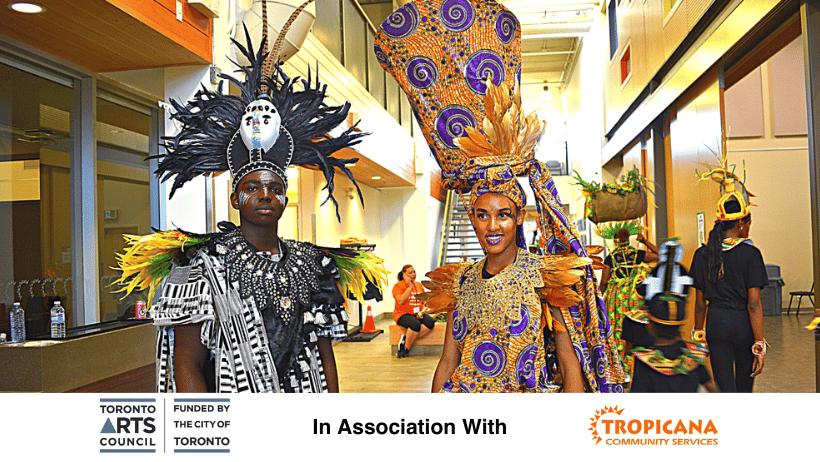
Caribana Kids Club & Mini Carnival
A two-week cultural summer camp offering 10 daily series of workshops that re-live and explore the traditions of Carnival through costume making, music, percussion, and dance.
We have once again partnered with Tropicana Community Services and the 2023 Caribana Kids Club will be offered as the programming for the first two weeks (Week 1 & 2) of Camp Tropicana (Tropicana’s Summer Camp Program).
This 2 week camp (9 days in 2023 due to the Canada Day holiday on July 3) will run from July 4-14. The final day of the camp will culminate with a Mini Carnival Presentation for parents, family and friends of our campers. Cost is $360/child. Fee includes a Tropicana T-shirt, costume kit, and mini carnival costume showcase on last day. Dinner is included as part of the carnival. This is the only meal included with this camp. There is no day trip for this camp.
This year’s camps will be held off-site at St. Ignatius of Loyola Catholic School, 2350 McCowan Road, Scarborough, approximately 0.8 km away from the Tropicana head office location.
To register, click on the Learn More button below, which will take you to the Tropicana Summer Camp Information page with Registration Link.
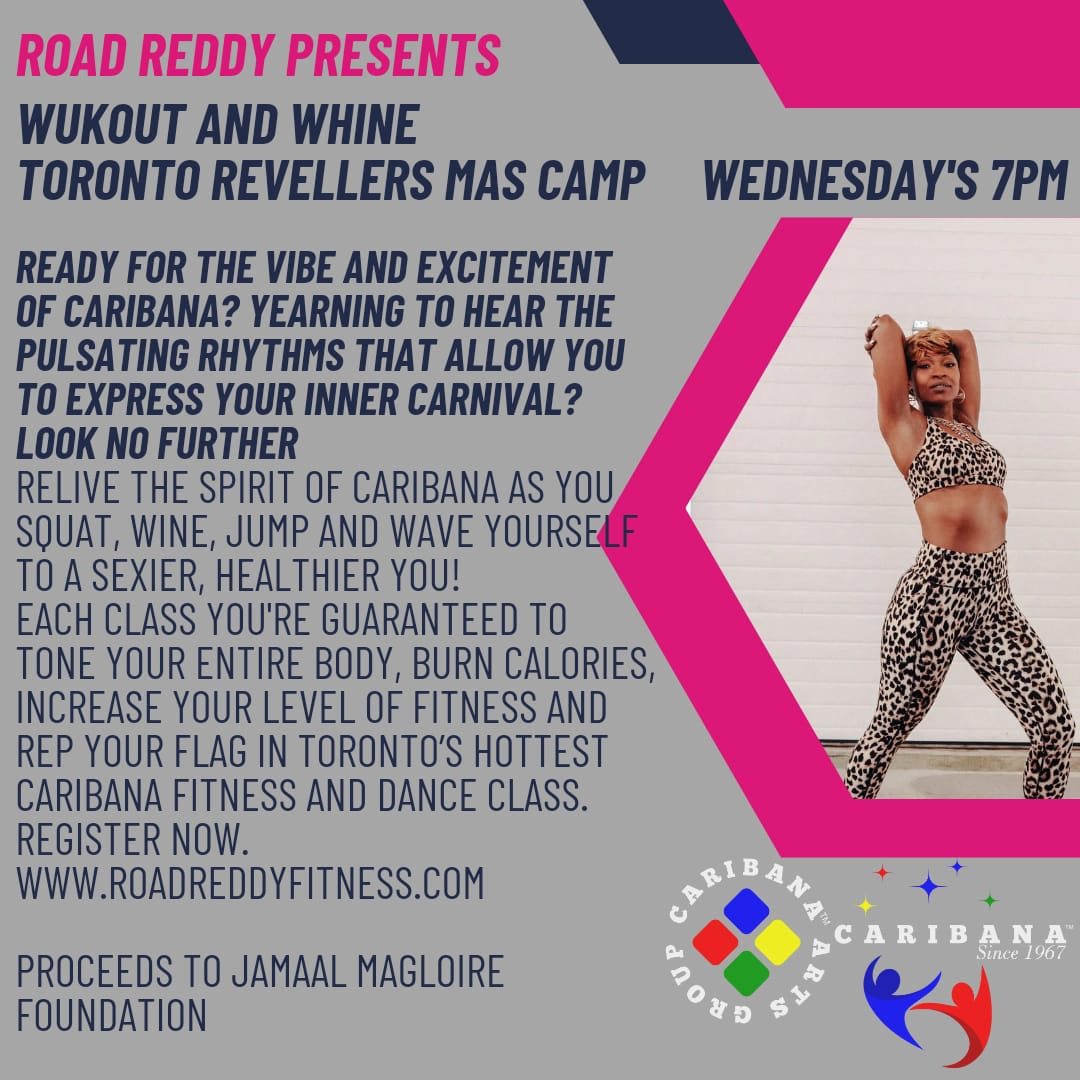
BANA BODY VIRTUAL FITNESS CLASSES
Ready for the vibe and excitement of Caribana? Yearning to hear the pulsating rhythms that allow you to express your inner carnival?
Look no further….. Caribana Arts Group presents Bana Body Fitness Classes hosted by Road Reddy Fitness!
Learn about your culture as well as some new moves that promote confidence through fitness. Enjoy a high-energy full-body workout that incorporates Afro-Caribbean Dance, Zumba, and popular Caribbean moves designed to make you SWEAT!
Jump up, rep your flag and gyrate those hips to the sweet sounds of Soca, Reggae, Zouk and more! Classes will be led by experienced instructors or in collaboration with community fitness experts who promote health and wellness within the Caribbean community. Get stronger, get leaner and work towards your Bana Body with energetic music and fitness fun. JOIN TODAY!!
CARIBANA ARCHIVES
Do you recall your first ever Caribana experience? Do you remember when Caribana used to be on University Ave? Or your favourite year with your crew down on the Lakeshore?
Caribana is officially collecting stories, videos and pics of your favourite Caribana memory. Continue adding to the legacy by submitting your footage and photos to be added to the digital collection.
This is a call to action for the community to send in your treasured memories or spectacular shots of the Grand Parade, King & Queen, Kiddies Carnival, Pan Alive, Official Launch dates, Calypso Tents and more.
